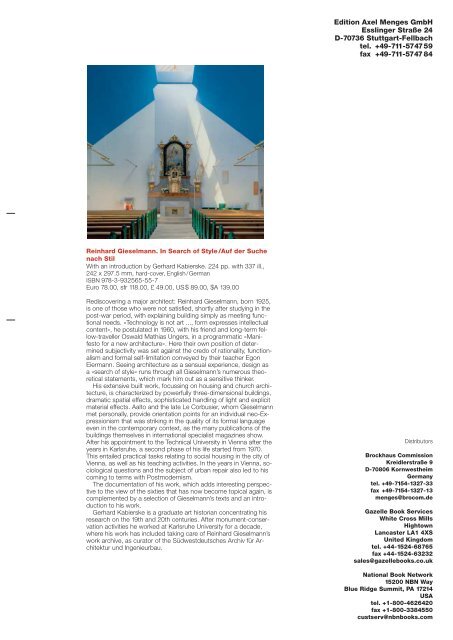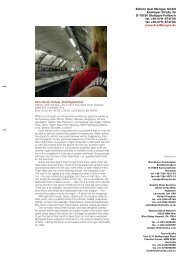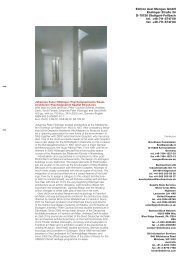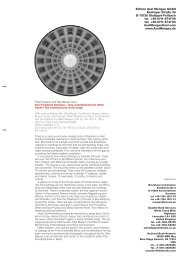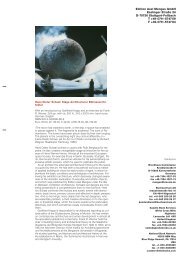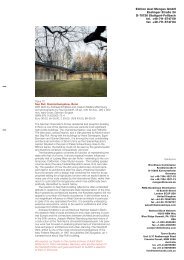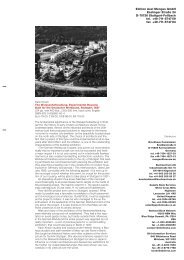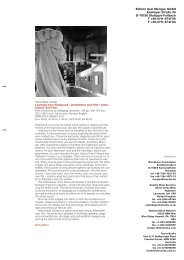PDF sample - Edition Axel Menges
PDF sample - Edition Axel Menges
PDF sample - Edition Axel Menges
You also want an ePaper? Increase the reach of your titles
YUMPU automatically turns print PDFs into web optimized ePapers that Google loves.
Reinhard Gieselmann. In Search of Style /Auf der Suche<br />
nach Stil<br />
With an introduction by Gerhard Kabierske. 224 pp. with 337 ill.,<br />
242 x 297.5 mm, hard-cover, English/German<br />
ISBN 978-3-932565-55-7<br />
Euro 78.00, sfr 118.00, £ 49.00, US$ 89.00, $A 139.00<br />
Rediscovering a major architect: Reinhard Gieselmann, born 1925,<br />
is one of those who were not satisfied, shortly after studying in the<br />
post-war period, with explaining building simply as meeting functional<br />
needs. »Technology is not art ..., form expresses intellectual<br />
content«, he postulated in 1960, with his friend and long-term fellow-traveller<br />
Oswald Mathias Ungers, in a programmatic »Manifesto<br />
for a new architecture«. Here their own position of determined<br />
subjectivity was set against the credo of rationality, functionalism<br />
and formal self-limitation conveyed by their teacher Egon<br />
Eiermann. Seeing architecture as a sensual experience, design as<br />
a »search of style« runs through all Gieselmann’s numerous theoretical<br />
statements, which mark him out as a sensitive thinker.<br />
His extensive built work, focussing on housing and church architecture,<br />
is characterized by powerfully three-dimensional buildings,<br />
dramatic spatial effects, sophisticated handling of light and explicit<br />
material effects. Aalto and the late Le Corbusier, whom Gieselmann<br />
met personally, provide orientation points for an individual neo-Expressionism<br />
that was striking in the quality of its formal language<br />
even in the contemporary context, as the many publications of the<br />
buildings themselves in international specialist magazines show.<br />
After his appointment to the Technical University in Vienna after the<br />
years in Karlsruhe, a second phase of his life started from 1970.<br />
This entailed practical tasks relating to social housing in the city of<br />
Vienna, as well as his teaching activities. In the years in Vienna, sociological<br />
questions and the subject of urban repair also led to his<br />
coming to terms with Postmodernism.<br />
The documentation of his work, which adds interesting perspective<br />
to the view of the sixties that has now become topical again, is<br />
complemented by a selection of Gieselmann’s texts and an introduction<br />
to his work.<br />
Gerhard Kabierske is a graduate art historian concentrating his<br />
research on the 19th and 20th centuries. After monument-conservation<br />
activities he worked at Karlsruhe University for a decade,<br />
where his work has included taking care of Reinhard Gieselmann’s<br />
work archive, as curator of the Südwestdeutsches Archiv für Architektur<br />
und Ingenieurbau.<br />
<strong>Edition</strong> <strong>Axel</strong> <strong>Menges</strong> GmbH<br />
Esslinger Straße 24<br />
D-70736 Stuttgart-Fellbach<br />
tel. +49-711-574759<br />
fax +49-711-5747 84<br />
Distributors<br />
Brockhaus Commission<br />
Kreidlerstraße 9<br />
D-70806 Kornwestheim<br />
Germany<br />
tel. +49-7154-1327-33<br />
fax +49-7154-1327-13<br />
menges@brocom.de<br />
Gazelle Book Services<br />
White Cross Mills<br />
Hightown<br />
Lancaster LA1 4XS<br />
United Kingdom<br />
tel. +44-1524-68765<br />
fax +44-1524-63232<br />
sales@gazellebooks.co.uk<br />
National Book Network<br />
15200 NBN Way<br />
Blue Ridge Summit, PA 17214<br />
USA<br />
tel. +1-800-4626420<br />
fax +1-800-3384550<br />
custserv@nbnbooks.com
Ein bedeutender Architekt ist neu zu entdecken:<br />
Reinhard Gieselmann, geboren 1925, zählt zu<br />
jenen, die sich schon bald nach ihrem Studium<br />
in der Nachkriegszeit nicht damit zufrieden gaben,<br />
Bauen allein aus der Erfüllung funktionaler<br />
Bedürfnisse zu erklären. »Technik ist nicht<br />
Kunst (...), Form ist Ausdruck des geistigen Gehaltes«,<br />
postulierte er 1960 zusammen mit seinem<br />
Freund und langjährigen Weggefährten<br />
Oswald Mathias Ungers in einem programmatischen<br />
»Manifest zu einer neuen Architektur«.<br />
Dem vom gemeinsamen Lehrer Egon Eiermann<br />
vermittelten Credo der Rationalität, des Funktionalismus<br />
und der formalen Selbstbeschränkung<br />
wurde darin die eigene Position eines gewollten<br />
Subjektivismus entgegengesetzt. Architektur als<br />
sinnliches Erlebnis zu verstehen, das Entwerfen<br />
als »Suche nach Stil«, durchzieht Gieselmanns<br />
zahlreiche theoretischen Äußerungen, die ihn<br />
als sensiblen Denker ausweisen.<br />
Sein umfangreiches bauliches Schaffen mit<br />
Schwerpunkt im Wohnhaus- und Kirchenbau ist<br />
geprägt von kraftvoll-plastischen Baukörpern,<br />
inszenierten Raumwirkungen, differenzierter<br />
Lichtregie und expliziter Materialwirkung. Alvar<br />
Aalto und der späte Le Corbusier, mit denen<br />
Gieselmann auch persönlich zusammentraf, bilden<br />
Orientierungspunkte für einen individuellen<br />
Neoexpressionismus, der in seiner qualitätvollen<br />
Formensprache schon im zeitgenössischen<br />
Kontext auffiel, wie die vielen Veröffentlichungen<br />
der Bauten selbst in internationalen Fachzeitschriften<br />
zeigen. Mit einem Ruf an die Technische<br />
Universität Wien begann nach den Jahren<br />
in Karlsruhe seit 1970 ein zweiter Lebensabschnitt,<br />
der neben der Lehrtätigkeit vor allem<br />
praktische Aufgaben im sozialen Wohnungsbau<br />
der Stadt Wien mit sich brachte. Soziologische<br />
Fragestellungen und das Thema der Stadtreparatur<br />
führten in den Wiener Jahren auch zu einer<br />
Auseinandersetzung mit der Postmoderne.<br />
Die Werkdokumentation, die den heute wieder<br />
aktuell gewordenen Blick auf die sechziger<br />
Jahre um interessante Perspektiven erweitert,<br />
wird ergänzt durch eine Auswahl von Texten<br />
Gieselmanns sowie eine Einführung in sein<br />
Schaffen.<br />
Gerhard Kabierske ist promovierter Kunsthistoriker<br />
mit einem Forschungsschwerpunkt in<br />
der Architektur des 19. und 20. Jahrhunderts.<br />
Nach Tätigkeit in der Denkmalpflege arbeitet er<br />
seit einem Jahrzehnt an der Universität Karlsruhe,<br />
wo er unter anderem als Kurator des Südwestdeutschen<br />
Archivs für Architektur und Ingenieurbau<br />
das Werkarchiv Reinhard Gieselmanns<br />
in seine Obhut genommen hat.<br />
078.00 Euro<br />
118.00 sfr<br />
049.90 £<br />
089.00 US $<br />
139.00 $A<br />
ISBN 978-3-932565-55-7<br />
9 783932 565557<br />
58900<br />
Reinhard Gieselmann <strong>Menges</strong><br />
Reinhard Gieselmann<br />
In Search of Style<br />
Auf der Suche nach Stil<br />
Rediscovering a major architect: Reinhard Gieselmann,<br />
born 1925, is one of those who were<br />
not satisfied, shortly after studying in the postwar<br />
period, with explaining building simply as<br />
meeting functional needs. »Technology is not<br />
art (...), form expresses intellectual content«,<br />
he postulated in 1960, with his friend and longterm<br />
fellow-traveller Oswald Mathias Ungers,<br />
in a programmatic »Manifesto for a new architecture«.<br />
Here their own position of determined<br />
subjectivity was set against the credo of rationality,<br />
functionalism and formal self-limitation<br />
conveyed by their teacher Egon Eiermann. Seeing<br />
architecture as a sensual experience, design<br />
as a »search of style« runs through all Gieselmann’s<br />
numerous theoretical statements, which<br />
mark him out as a sensitive thinker.<br />
His extensive built work, focussing on housing<br />
and church architecture, is characterized<br />
by powerfully three-dimensional buildings, dramatic<br />
spatial effects, sophisticated handling of<br />
light and explicit material effects. Aalto and the<br />
late Le Corbusier, whom Gieselmann met personally,<br />
provide orientation points for an individual<br />
neo-Expressionism that was striking in the<br />
quality of its formal language even in the contemporary<br />
context, as the many publications of<br />
the buildings themselves in international specialist<br />
magazines show. After his appointment to<br />
the Technische Universität in Vienna after the<br />
years in Karlsruhe, a second phase of his life<br />
started from 1970. This entailed practical tasks<br />
relating to social housing in the city of Vienna,<br />
as well as his teaching activities. In the years in<br />
Vienna, sociological questions and the subject<br />
of urban repair also led to his coming to terms<br />
with Postmodernism.<br />
The documentation of his work, which adds<br />
interesting perspective to the view of the sixties<br />
that has now become topical again, is complemented<br />
by a selection of Gieselmann’s texts<br />
and an introduction to his work.<br />
Gerhard Kabierske is a graduate art historian<br />
concentrating his research on the 19th and 20th<br />
centuries. After monument-conservation activities<br />
he worked at Karlsruhe University for a decade,<br />
where his work has included taking care<br />
of Reinhard Gieselmann’s work archive, as curator<br />
of the Südwestdeutsches Archiv für Architektur<br />
und Ingenieurbau.
Old-age home of the Deutsches Rotes<br />
Kreuz, Karlsruhe, 1962–67<br />
In order to get sunlight even on the courtyard<br />
side, which faces north, the rear of the building<br />
was rotated slightly toward the west. This created<br />
a triangular lobby in the center with light through<br />
the ceiling for all five floors – and the corridors<br />
became galleries, so that the residents have a<br />
view of all floors and the lobby. The two-storey<br />
entrance hall with a freestanding elevator tower<br />
and a freestanding staircase faces the street with<br />
a large articulated glass wall in order to keep the<br />
residents in closer contact with what is happening<br />
in the outside world. The pillars, which also contain<br />
the wiring, connect with the ceiling by means<br />
of capitals. One wall is ornamented with a relief,<br />
a colorful ceramic work by the painter Karl-Heinz<br />
Overkott. A two-level dining hall with a terrace in<br />
front of it adjoins the entrance hall. The hallway of<br />
the two-storey tract of rooms in the main building<br />
is lit by a skylight. The rooms on the courtyard<br />
side have small terraces. The roof and terraces<br />
of the community rooms in the main building are<br />
connected by outside staircases that go up to the<br />
roof terrace. At the north end of the grounds there<br />
is a one-storey tract with two-room assisted-living<br />
apartments.<br />
The façade is underlaid with a grid. Since the<br />
loggias and windows on one side mirror those on<br />
the other, their positions – in spite of the grid – are<br />
individual, and thus it is easier for a resident to<br />
recognize his/her room more easily.<br />
106<br />
Altenheim des Deutschen Roten Kreuzes,<br />
Karlsruhe, 1962–67<br />
Um auch auf der nach Norden orientierten Hofseite<br />
Sonne zu bekommen, wurde die Rückseite<br />
etwas nach Westen abgedreht. Dadurch entstand<br />
in der Mitte eine dreieckige Halle mit Licht durch<br />
das Dach für alle fünf Geschosse – und die Flure<br />
wurden zu Galerien, so daß die Bewohner alle<br />
Geschosse und die Halle überblicken können.<br />
Die zweigeschossige Eingangshalle mit frei stehendem<br />
Aufzugturm und ebensolcher Treppe ist<br />
mit einer gegliederten, großen Glaswand auf die<br />
Straße gerichtet, um das Erlebnispotential der<br />
Bewohner zu stärken. Die Stützen, die auch die<br />
Leitungen aufnehmen, schließen mit Kapitellen<br />
an die Decke an. Eine Wand ist mit einem Relief<br />
geschmückt, zu dem der Maler Karl-Heinz Overkott<br />
die farbige Keramik lieferte. Ein Speisesaal<br />
auf zwei Ebenen mit vorgelagerter Terrasse schließt<br />
sich an die Eingangshalle an. Der Flur des zweigeschossigen<br />
Zimmertrakts im Hauptgebäude wird<br />
durch ein Oberlicht erhellt. Die hofseitigen Zimmer<br />
haben kleine Terrassen. Dach und Terrassen der<br />
Gemeinschaftsräume des Hauptgebäudes sind<br />
über Außentreppen erreichbar. Im nördlichen<br />
Grundstücksbereich befindet sich ein eingeschossiger<br />
Trakt mit Zweizimmerwohnungen für selbstversorgende<br />
Bewohner.<br />
Die Fassade ist mit einem Raster unterlegt.<br />
Da die Loggien und Fenster auch spiegelbildlich<br />
verwendet wurden, ergeben sich – trotz Raster –<br />
individuelle Positionen von beiden, und damit entsteht<br />
für den Bewohner eine leichtere Erkennbarkeit<br />
seines Raumes von außen.<br />
1. View from the street.<br />
2. Site plan.<br />
1. Ansicht von der Straße.<br />
2. Lageplan.<br />
p. 108, 109<br />
3. Roofscape on the main building.<br />
4. View of the main building from the courtyard.<br />
5–7. Floor plans (ground floor, upper floors) and<br />
section of the main building.<br />
S. 108, 109<br />
3. Dachlandschaft auf dem Hauptgebäude.<br />
4. Ansicht des Hauptgebäudes vom Hof.<br />
5–7. Grundrisse (Erdgeschoß, Obergeschosse)<br />
und Schnitt des Hauptgebäudes.<br />
107
108<br />
109
8, 9. Lobby in the main building. 8, 9. Halle im Hauptgebäude.<br />
110<br />
111
Church of St. Valentin am Forst, Landschach,<br />
Lower Austria, 1986–90<br />
The little 13th-century church on the outskirts of<br />
the village was rebuilt after the 17th and 18th century<br />
Turkish Wars. Before it was rebuilt, it consisted<br />
of a nave with a somewhat insensitively builton<br />
Lady chapel, a relatively large, angled chancel,<br />
a tower opposite it, and a narrow side aisle with a<br />
built-on charnel house (ossuary), whose cellar was<br />
still full of bones from the Turkish Wars when construction<br />
began.<br />
The old entrance determined the new spatial<br />
axis, which made it possible to create a hierarchy<br />
of spaces: The side aisle became a two-sided<br />
worship space with two altars, the ossuary a confessional,<br />
and the former chancel became the<br />
day-to-day chapel. The Baroque chapel had to<br />
make way for the addition, which is set off from<br />
the old building by two floor-to-ceiling windows<br />
with depictions of the patron saints; also, the windows<br />
of the small chancel, which had been enlarged<br />
during the Baroque period, were restored<br />
to their original Gothic form. Lastly, the Baroque<br />
main altar, which was too high for the space, was<br />
moved to the new, much higher chancel wall. The<br />
nave holds part of the seats of the added nave.<br />
As you walk through between the red pillars Boaz<br />
and Jachin, which support the weight of the new<br />
double-pitched roof that intersects with the old<br />
vault, you see before you, at the end of the center<br />
aisle, the new celebration altar and the old high<br />
altar behind it in the middle of the widening nave –<br />
and above them the glass ridge, which becomes<br />
larger toward the altar. The village houses are mirrored<br />
in the glass, and the ridge can create an<br />
east-west light pendulum effect that lasts as long<br />
as a mass.<br />
Materials and colors: The floor is made of Solnhofen<br />
slabs, rough and polished, ochre like the<br />
earth; old bench ends – lush green, like vegetation;<br />
third dimension – blue, like the sky at times.<br />
Kirche St. Valentin am Forst, Landschach,<br />
Niederösterreich, 1986–90<br />
Die am Dorfrand gelegene kleine Kirche aus dem<br />
13.Jahrhundert wurde nach den Türkenkriegen<br />
im 17. und 18. Jahrhundert wieder aufgebaut. Vor<br />
ihrem Umbau bestand sie aus einem Hauptschiff<br />
mit einer etwas gefühllos angebauten Marienkapelle,<br />
einem relativ großen, abgewinkelten Chor,<br />
einem Turm ihm gegenüber sowie einem schmalen<br />
Seitenschiff mit angebautem Karner (Beinhaus),<br />
dessen Keller bei Baubeginn noch voller<br />
Knochen aus den Türkenkriegen war.<br />
Der alte Eingang gab die neue Raumachse<br />
vor, die eine Hierarchie der Räume entstehen ließ:<br />
Aus dem Seitenschiff wurde ein zweiseitiger Andachtsraum<br />
mit zwei Altären, aus dem Karner ein<br />
Beichtzimmer und aus dem alten Chor die Alltagskapelle.<br />
Dem Zubau, der durch zwei geschoßhohe<br />
Fenster mit den Darstellungen der Patronatsheiligen<br />
vom Altbau abgesetzt ist, mußte die Barockkapelle<br />
weichen, ebenso erhielten auch die im<br />
Barock vergrößerten Fenster des kleinen Chores<br />
wieder ihre gotische Urform. Schließlich wurde der<br />
für den Raum zu hohe barocke Hauptaltar an die<br />
neue, viel höhere Chorwand versetzt. Das Haupt-<br />
164<br />
schiff nimmt einen Teil der Bänke des Anbauschiffs<br />
auf. Geht man zwischen den roten Säulen<br />
Boas und Jachym hindurch, mit denen die Last<br />
des sich mit dem alten Gewölbe verschneidenden<br />
neuen Satteldachs abgefangen wird, hat man am<br />
Ende des Mittelgangs den neuen Zelebrationsaltar<br />
und dahinter den alten Hochaltar inmitten des<br />
sich verbreiterten Schiffes vor sich – und darüber<br />
den zum Altar hin vergrößerten gläsernden First,<br />
in dem sich die Dorfhäuser spiegeln und der eine<br />
Ost–West-Wanderung des Sonnenlichts in der<br />
Zeit der Messe erzeugen kann.<br />
Materialien und Farben: Boden Solnhofener<br />
Platten, rauh und geschliffen, ockerfarben wie<br />
die Erde; alte Bankhäupter sattgrün wie der Bewuchs;<br />
dritte Dimension blau wie oft der Himmel.<br />
1, 2. Floor plans of the church before and after<br />
conversion.<br />
3. View from the south-west.<br />
4. View from the north-east.<br />
1, 2. Grundrisse der Kirche vor und nach dem<br />
Umbau.<br />
3. Ansicht von Südwesten.<br />
4. Ansicht von Nordosten.<br />
165
166<br />
5. View of the side-chapel on the south side.<br />
6. View of the new nave from the old one.<br />
7. View of the new nave towards the altar.<br />
5. Blick in die Seitenkapelle auf der Südseite.<br />
6. Blick vom alten in das neue Schiff.<br />
7. Blick in das neue Schiff in Richtung Altar.<br />
167


